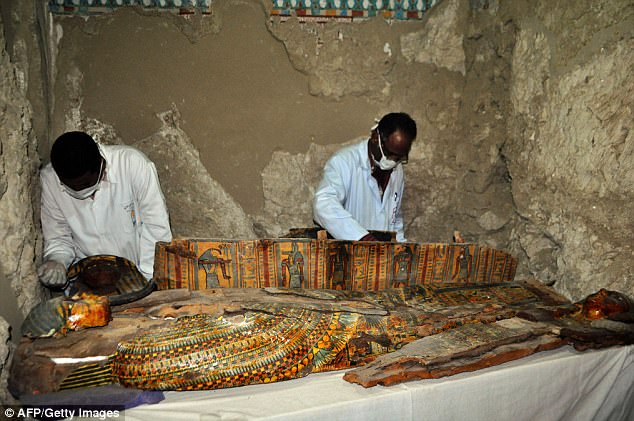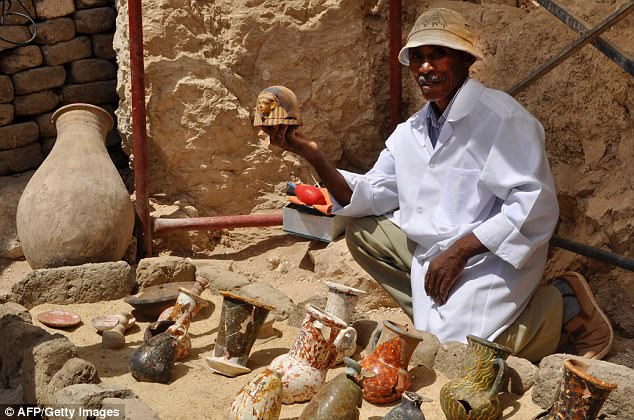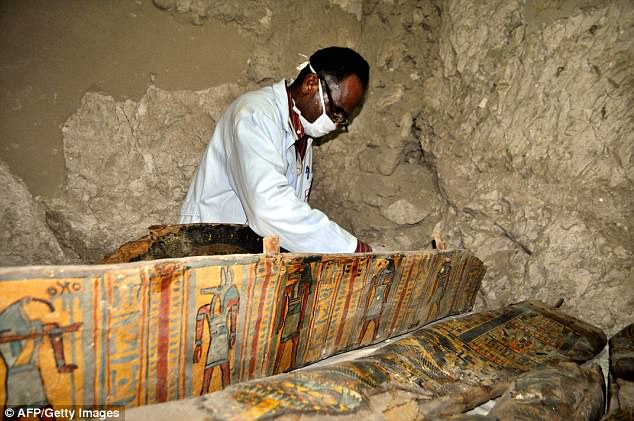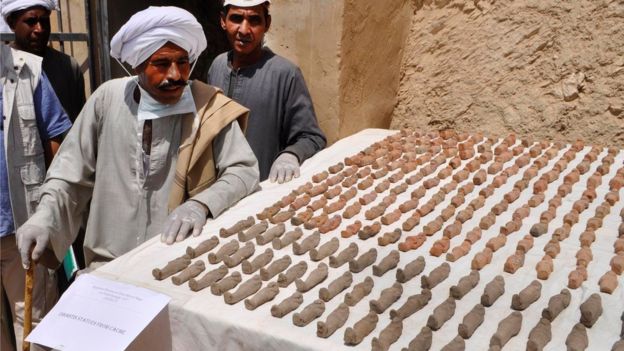DepthReading
Revealed: EIGHT MUMMIES and a treasure trove of artefacts are unearthed in a 3,500-year-old tomb near the ancient city of Luxor
Archaeologists exploring a mysterious tomb in Egypt were in for a surprise when they discovered more than 1,000 statues and eight mummies.
The incredible haul was found in an ancient noble's tomb on the west bank of the Nile River in Luxor.
Little is known about who the mummies belong to, but the team says it expects to find even more statues as the dig continues.
The 18th Dynasty tomb, discovered in the Draa Abul Nagaa necropolis near the famed Valley of the Kings, belonged to a nobleman named Userhat who worked as the city judge, the ministry said in a statement.
It was opened to add more mummies during the 21st Dynasty, about 3,000 years ago, to protect them during a period when tomb-robbing was common, said Waziri, the head of the archaeological mission, at the site.
'It was a surprise how much was being displayed inside the tomb', Antiquities Minister Khaled el-Enany told reporters outside the tomb.
'We found a large number of Ushabti (small carved figurines), more than 1,000 of them,' Mr Enany said.
Archaeologists were also examining a mummy wrapped in linen (pictured) which was inside one of the coffins
'It was a surprise how much was being displayed inside the tomb', Antiquities Minister Khaled el-Enany (pictured left) told reporters outside the tomb
Ushabti figurines were often placed with the deceased in ancient Egyptian tombs to help with responsibilities in the afterlife
Pictured is the intricately painted face of one of the coffins, which held one of eight mummies discovered in the tomb
'This is an important discovery,' he added.
Ushabti figurines were often placed with the deceased in ancient Egyptian tombs to help with responsibilities in the afterlife.
Inside the tomb, archaeologists wearing white masks and latex gloves inspected the sarcophagi, which were covered with intricate drawings in red, blue, black, green, and yellow, and featured the carved faces of the dead.
Inside the rectangular hall, a well-preserved wooden coffin, decorated with coloured scenes, was unearthed and a nine metres deep shaft was uncovered
Archaeologists wearing white masks and latex gloves inspected the sarcophagi, which were covered with intricate drawings in red, blue, black, green, and yellow, and featured the carved faces of the dead
A member of the Egyptian archaeological team shows artifacts discovered in the 3,500-year-old tomb in the Draa Abul Nagaa necropolis
Several skulls were also found by the Egyptian archaeologists at the tomb of Userhat, although it is unclear who they belonged to
The coffins were mainly well-preserved, though some had deteriorated and broken over the years.
Archaeologists were also examining a mummy wrapped in linen which was inside one of the coffins.hite, orange, green, and patterned pots were also found in the tombs.
Inside the shaft, the mission located two rooms; one on the eastern side, where a collection of ushabti figurines, wooden masks (pictured) and a handle of a sarcophagus lid was unearthed
After removing almost 450 metres of debris out of the open court, the researchers discovered the entrance of the tomb as well as two other entrances leading to two joint tombs
The wooden coffins had intricate drawings in red, blue, black, green, and yellow, and featured the carved faces of the dead
Nevine el-Aref, the spokeswoman for the antiquities ministry, said 'there is evidence and traces that new mummies could be discovered in the future'
'It is a T-shaped tomb (which) consists of an open court leading into a rectangular hall, a corridor and an inner chamber,' the ministry said in a statement.
A nine-metre shaft inside the tomb held the Ushabti figurines, as well as 'wooden masks and a handle of a sarcophagus lid,' the ministry said.
Another room in the tomb was also discovered, though it has not yet been completely excavated, it said.
Nevine el-Aref, the spokeswoman for the antiquities ministry, said 'there is evidence and traces that new mummies could be discovered in the future.'
Pictured are two of the eight mummies discovered in the tomb. Researchers hope to find more mummies as they excavate the area further
Another chamber was found containing the statues, which depict kings from different dynasties (pictured)
A collection of ushabti figurines carved in faience, terracotta and wood was also unearthed as well as another collection of clay pots of different shapes and sizes
The incredible haul was found in an ancient noble's tomb on the west bank of the Nile River in Luxor
Category: English
DepthReading
Key words:
















